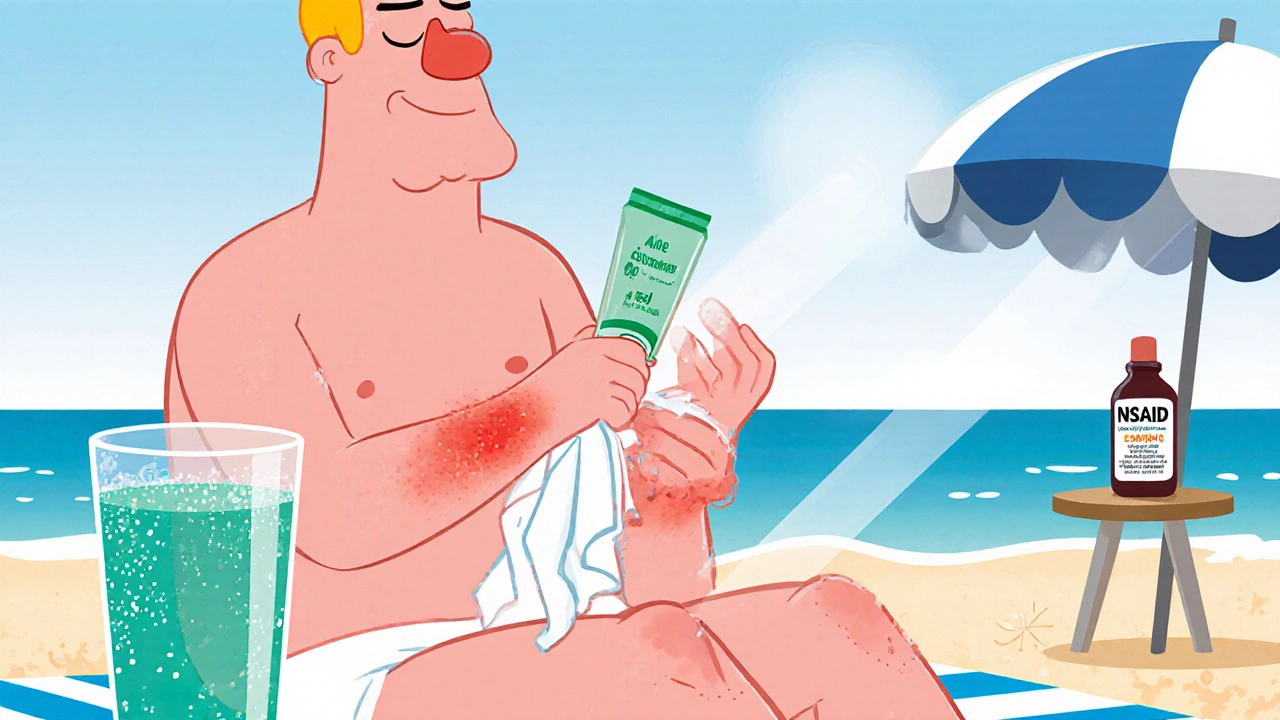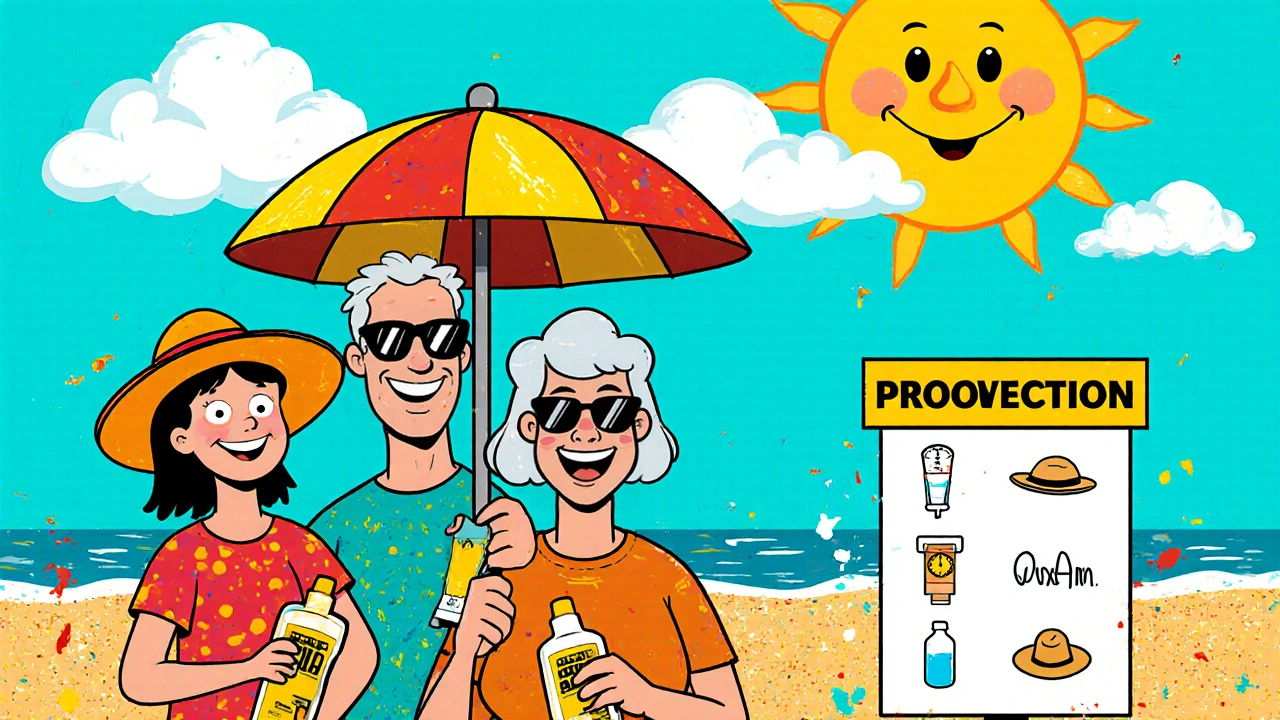Sunburn vs Photoallergy Symptom Checker
Identify Your Sun Reaction
Answer a few simple questions about your symptoms to determine whether you're experiencing sunburn or photoallergy. Based on your answers, we'll provide tailored treatment recommendations.
Prevention Tip
Always wear broad-spectrum sunscreen with SPF 30+ and protective clothing. Reapply sunscreen every 2 hours or after swimming.
Managing sunburn and allergies can feel overwhelming, especially when the two conditions flare up together. One minute you’re enjoying a summer barbecue, the next you’re battling red, painful skin and itchy welts. This guide breaks down what’s happening under the surface, how to tell the two apart, and what you can do right now to soothe yourself and keep future reactions at bay.
What actually happens when UV light hits your skin?
UV radiation is electromagnetic energy from the sun that penetrates the outer skin layers. It comes in three bands-UVA, UVB, and UVC. UVC is filtered by the atmosphere, but UVA and UVB reach the ground. UVB is the main culprit behind sunburn, while UVA can trigger deeper, delayed reactions like photoallergies.
Sunburn: The classic burn
When UVB overloads the skin’s natural defenses, DNA in skin cells gets damaged. The body responds with inflammation, causing the familiar red, hot, and sometimes blistered appearance. Most people notice the pain within a few hours, and the peak redness hits around 12‑24 hours after exposure.
Key attributes of a true sunburn include:
- Rapid onset (within a few hours)
- Uniform redness that matches the exposed area
- Heat, swelling, and possible blister formation
- Peeling after 2‑4 days as damaged skin sheds
Photoallergy: When the sun triggers an immune response
Photoallergy is an immune‑mediated skin reaction that occurs after sunlight activates a chemical or protein in the skin. Unlike a burn, the reaction can take 24‑48 hours to appear, and it often looks patchy, itchy, or hive‑like.
Typical signs of a sun‑induced allergy include:
- Delayed itching or swelling (often >24 hours after exposure)
- Irregular, raised welts (urticaria) or eczematous patches
- Rash that may spread beyond the sun‑exposed zones
- Accompanying symptoms such as watery eyes or nasal congestion
Spotting the difference: Quick visual checklist
| Feature | Sunburn | Photoallergy |
|---|---|---|
| Onset | Within hours | 24‑48 hours |
| Texture | Smooth, may blister | Raised, itchy welts or eczematous patches |
| Distribution | Uniform to exposed area | Patchy, can spread beyond exposure |
| Accompanying signs | Heat, swelling, peeling | Itching, hives, watery eyes |

Immediate relief: What to do the moment you notice a reaction
Regardless of whether you’re dealing with a burn or an allergy, the first 30 minutes are critical. Follow these steps:
- Cool the skin: Apply a cool (not icy) compress for 10‑15 minutes. For sunburn, a damp cloth works; for allergy‑related itching, a cool gel pack can calm the nerves.
- Cooling gels are topical preparations containing aloe, cucumber, or menthol that provide a soothing, anti‑inflammatory effect. Apply a thin layer after cooling.
- Hydrate from inside out: Drink at least 500 ml of water per hour for the next few hours. Proper hydration speeds skin repair.
- If pain is intense, consider an oral NSAID such as ibuprofen, which reduces inflammation and pain.
Targeted treatments for sunburn
Once the initial cooling is done, focus on protecting the damaged barrier.
- Moisturizer with ceramides, hyaluronic acid, or glycerin helps restore lipid layers and reduces peeling.
- For blistered areas, keep them clean and covered with a non‑stick sterile pad. Avoid popping blisters-they act as a natural barrier.
- Over‑the‑counter topical corticosteroids (1% hydrocortisone) can be used sparingly if inflammation is severe, but limit use to 3‑4 days.
Targeted treatments for photoallergy
Allergic reactions need anti‑histamine and sometimes stronger anti‑inflammatory measures.
- Oral antihistamines such as cetirizine or loratadine reduce itching and swelling.
- If welts are extensive, a short course of oral corticosteroids (e.g., prednisone) may be prescribed by a doctor.
- Topical calamine lotion can soothe itchy patches without irritating the skin.

Daily prevention: Building a sun‑smart routine
Prevention beats treatment every time. Adopt these habits year‑round, not just in summer.
- Broad‑spectrum sunscreen: Choose SPF 30 or higher that blocks both UVA and UVB. Apply 15‑30 minutes before stepping out, and reapply every two hours or after swimming.
- Wear protective clothing, such as UPF‑rated shirts, wide‑brim hats, and UV‑blocking sunglasses.
- Seek shade during peak UV hours (10 a.m. to 4 p.m.). Even on cloudy days, up to 80% of UV rays penetrate.
- Stay hydrated: Aim for at least 2 liters of water daily to keep skin elasticity high.
- If you have a known photoallergy, consider taking a single antihistamine dose before extended sun exposure.
Special cases: Children, seniors, and people with chronic skin conditions
Kids have thinner skin, so they burn faster. Use mineral‑based sunscreens (zinc oxide or titanium dioxide) and apply more frequently. Seniors often have reduced skin turnover, making healing slower-opt for richer moisturizers and avoid harsh chemicals.
Those with eczema or psoriasis should test any new sunscreen on a small area first, as fragrance or alcohol can trigger flare‑ups.
When to call a professional
If any of the following signs appear, schedule a visit with a dermatologist:
- Blisters covering more than 10% of the body
- Severe pain that doesn’t improve with OTC pain relievers
- Fever, chills, or nausea (possible sunstroke)
- Rash that spreads rapidly or is accompanied by difficulty breathing
- Persistent itching beyond 72 hours despite antihistamines
Early intervention can prevent infection, scarring, or chronic photosensitivity.
FAQ
Can I treat sunburn and photoallergy with the same product?
Not usually. Sunburn benefits from cooling gels, moisturizers, and occasional topical steroids, while photoallergy needs antihistamines and anti‑inflammatory creams. Mixing them can reduce effectiveness.
Is sunscreen enough to prevent photoallergy?
Sunscreen is a key layer, but people with strong photosensitivity may still react to UVA that penetrates some formulas. Adding protective clothing and a pre‑emptive antihistamine provides extra safety.
How long does a sunburn last?
Mild burns typically heal in 3‑5 days, while medium to severe burns may take 7‑10 days, including peeling and new skin formation.
Can I use aloe vera for a sun‑induced allergy?
Aloe vera is great for sunburn because of its cooling effect, but it won’t stop the immune response in a photoallergy. Pair it with an antihistamine for best results.
Should I avoid the sun completely after a reaction?
Give the skin a few days to recover, then re‑introduce sunlight gradually while using high‑SPF sunscreen and protective clothing. Complete avoidance isn’t necessary unless directed by a doctor.
By understanding the science behind each reaction and arming yourself with the right tools, you can enjoy the outdoors without the dreaded after‑effects. Whether it’s a mild burn or a stubborn allergic flare‑up, the steps above will help you recover faster and stay protected for the next sunny adventure.

Mike Peuerböck
Sun protection is a habit you can build, just like brushing your teeth. Start by choosing a broad‑spectrum SPF 30+ and apply it 15 minutes before stepping outdoors. Reapply every two hours, especially after swimming or sweating, to keep the barrier intact. If you feel a burn coming on, a cool compress and a splash of aloe will calm the inflammation fast. Hydration from the inside out speeds skin repair and keeps you feeling energetic.
Simon Waters
They don’t want you to know the real sunscreen ingredients.
Celeste Flynn
When you first notice a red patch, the fastest way to decide if it’s a burn or a photoallergy is the timing. Sunburn usually peaks within 12‑24 hours, while a photoallergic reaction can take a full day or two to appear. Cooling the area with a damp cloth for ten minutes reduces heat and soothes nerve endings, but it won’t stop the immune response behind an allergy. For itchiness, an oral antihistamine such as cetirizine works better than aloe alone. Keep your skin moisturized with a ceramide‑rich cream to restore the barrier after the heat subsides. If blisters develop, cover them with a non‑stick pad and avoid popping – the blister is a natural shield. Should the rash spread beyond the sun‑exposed zones, schedule a dermatologist visit promptly. Remember, consistent sunscreen use plus protective clothing cuts both problems down dramatically.
CASEY PERRY
UVB induces DNA photodamage → inflammatory cascade; UVA catalyzes photo‑immunomodulation. Immediate intervention: cool compress → ↓ temperature, topical NSAID → COX inhibition. Follow with barrier restitution: ceramides + hyaluronic acid. Antihistamines address histamine‑mediated urticaria.
Jennell Vandermolen
It’s easy to feel overwhelmed when the sun turns from friend to foe, but you’ve got tools at hand. Start with a solid sunscreen routine, then add a simple cooling gel if you notice heat. If itching shows up later, reach for an over‑the‑counter antihistamine – it can make a big difference. Keep water nearby; staying hydrated helps skin heal faster. And if you ever see large blisters or a rash that won’t quit, don’t wait – see a dermatologist. You’re doing great by learning these steps, so keep them in your sun‑smart toolkit.
Vikas Kumar
Our country’s sun is a blessing, yet western labs push chemicals that damage our skin. Don’t trust foreign sunscreen formulas, stick to locally‑made mineral options. A simple cold water splash and plain aloe can beat any imported cream.
Shan Reddy
I’ve tried the cool‑gel method on a bad burn last summer and it actually helped the swelling go down fast. After that I slathered on a thick moisturizer with ceramides and the peeling was much milder. If you get itchy welts, an antihistamine works better than just scratching. Just remember to reapply sunscreen every two hours, even on cloudy days. Staying in the shade during peak hours also saves a lot of trouble.
Naomi Shimberg
While the prevailing consensus extols broad‑spectrum sunscreens as panacea, one must consider that certain UVA filters may themselves act as photosensitizers. Consequently, relying solely on sunscreen without adjunctive protective garments could paradoxically exacerbate photoallergic manifestations. It is therefore prudent to evaluate the photostability of any topical agent prior to extensive exposure. Moreover, a pre‑emptive antihistamine dose may be warranted for individuals with documented sensitivities, contrary to the usual recommendation of sunscreen alone.
kenny lastimosa
Sunlight is a double‑edged sword, gifting life yet demanding respect. When the skin burns, it sends a message that the boundary has been crossed, a reminder of our mortality. A photoallergy, on the other hand, is the immune system’s way of protesting an invisible intrusion, a silent protest of the body’s own defenses. Both conditions share the common thread of inflammation, yet their origins lie in different pathways-one physical, the other immunological. The first thirty minutes after exposure are critical; cooling the skin is akin to pausing the conversation before it escalates into shouting. Hydration acts as a mediator, allowing cellular repair processes to proceed efficiently. Topical treatments, whether aloe for burns or calamine for itching, provide comfort but do not resolve the underlying trigger. Oral NSAIDs reduce pain, while antihistamines calm the histamine storm, each addressing a separate symptom. Prevention, however, remains the most elegant solution: shade, clothing, and a reliable sunscreen form a triad of defense. It is worth noting that not all sunscreens are created equal; mineral-based formulas tend to be less likely to provoke photoallergic reactions. For those with chronic skin conditions, a patch test before full application can spare weeks of discomfort. If blisters appear on more than ten percent of the body, professional medical care is indispensable. Persistent itching beyond three days signals that the body is still engaged in a battle it cannot win alone. Ultimately, listening to the skin’s signals and responding with both immediate care and long‑term strategy is the hallmark of true sun wisdom. In this dance with the sun, knowledge and preparation are the steps that keep us from stumbling.
prithi mallick
i totally agree with kenny, u gotta listen to ur skin . a quick cool cloth and some water really help . also dont forget the antihistamine if the welts wont go away .
Michaela Dixon
Imagine stepping out into a golden afternoon, the sun spilling its honeyed light across the sky, only to find your skin singing a painful chorus of redness and itch. That moment, while disconcerting, is also a vivid reminder of how our bodies are wonderfully complex machines, capable of both burning and reacting to the very photons that nourish life. The key to turning that discomfort into a manageable experience lies in the simple, yet often overlooked, act of cooling – a splash of water, a damp towel, or even a cucumber slice can feel like a gentle lullaby for inflamed nerves. Once the heat subsides, a generous dab of aloe‑laden gel provides not only soothing moisture but also a subtle, verdant scent that evokes summer breezes. If the irritation morphs into those tell‑tale hive‑like welts, reaching for an over‑the‑counter antihistamine is akin to calling in a calm mediator to settle the dispute. And let us not forget the unsung hero of this routine: hydration, the internal river that carries nutrients to skin cells, ensuring they rebuild their protective barrier with graceful efficiency. By weaving together these colorful threads – cooling, moisturizing, antihistamines, and water – you craft a tapestry of relief that lets you once again bask in sunshine’s warm embrace without fearing the sting.
Dan Danuts
Hey folks, just wanted to share that I keep a small cooler in my backpack during beach trips. When the sun hits hard I slap on a cool gel and it feels like instant relief. I also mix a little bit of oat‑milk lotion with my sunscreen for extra comfort. Staying in the shade for a bit after a long swim helps my skin recover faster. Give it a try, you’ll thank yourself later!
Dante Russello
First and foremost, remember that sun safety is a shared responsibility, and every small step you take contributes to a healthier community, so apply sunscreen generously, reapply frequently, and choose a broad‑spectrum formula with SPF 30 or higher; second, incorporate protective clothing, such as UPF‑rated shirts and wide‑brim hats, because physical barriers complement chemical protection, and third, stay hydrated by drinking water throughout the day, as hydration supports skin regeneration and overall well‑being; finally, if you experience persistent redness, itching, or blisters, consult a dermatologist promptly, because early intervention can prevent complications and promote faster healing.
James Gray
Yo! Sun’s awesome but don’t let it burn you, just slather on that SPF and wear a cool hat. If you get a rash, a quick antihistamine will chill it out fast. Keep a water bottle handy – hydration is key. You’ll be back to enjoying the vibes in no time!